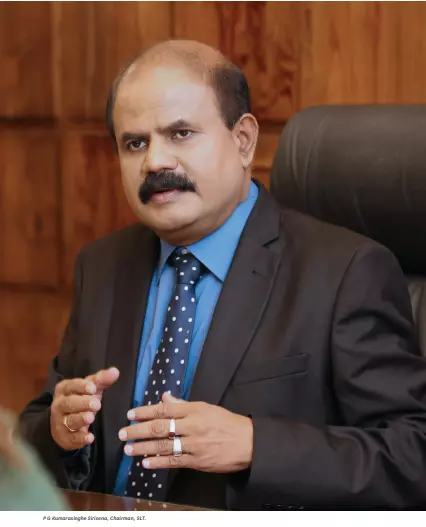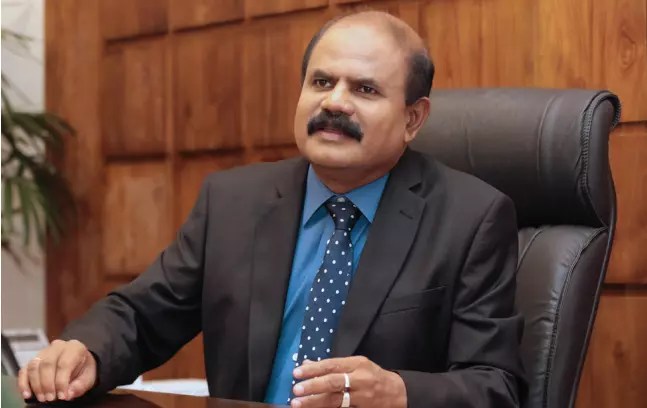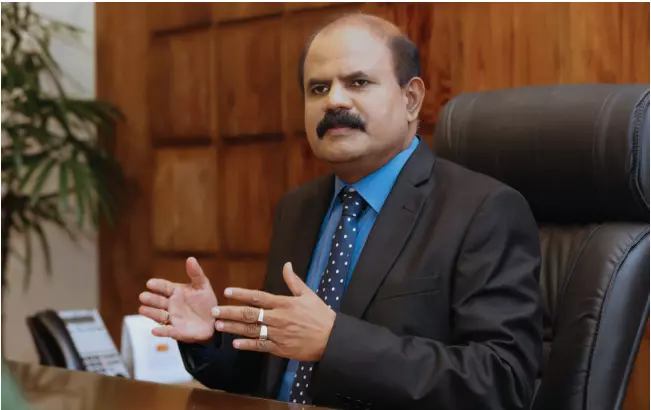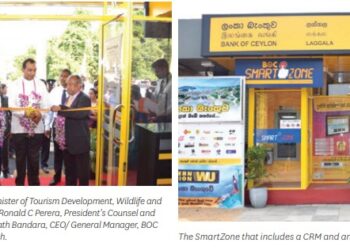Sri Lanka Telecom (SLT) achieved great feats in taking Sri Lanka to the next level of technological advancement in 2018. Leveraging on this momentum, SLT launched the National Digital Roadmap to transform the lives of all Sri Lankans through digital solutions. These planned initiatives are being implemented under SLT’s theme of “Limitless You,” encompassing Sri Lanka’s transformation as a digitized nation and looking at the needs of employees, customers, and the public. P G Kumarasinghe Sirisena, Chairman, SLT states that this is part of SLT’s transition to becoming the leading digital services provider in Sri Lanka. Citing the continued investment of the telecommunications provider in the country, he elaborates that Sri Lanka Telecom has an extremely positive outlook on Sri Lanka’s future.
By Udeshi Amarasinghe and Keshini De Silva. | Photography Mahesh Bandara and Menaka Aravinda.

Sri Lanka Telecom recently launched the Digital Roadmap towards digitization of the Nation. What does it mean for the people and the country?
For 162 years, Sri Lanka Telecom including Mobitel, has been the leader in telecommunications in Sri Lanka. However, today, the needs of the public go beyond telecommunications where incorporating technology is essential for comfortable living. In the past, telecommunications were merely restricted to communicating over the phone. However, today, it is more to do with using broadband technology for smart living. We have moved from being a leading Communications Service Provider (CSP) in Sri Lanka to a Digital Service Provider (DSP). In the future, we will be launching a new concept in line with this transition. The population of Sri Lanka exceeds 21 million. Therefore, we have a theme for our journey towards digitization. The most significant impact on digitization is human influence. Here, in Sri Lanka, 75 percent of the effect is in terms of the dedication of Sri Lankans towards this technology.
Our Theme For This Journey Is “Limitless You”. This Means That The 21 Million People In The Country Are Limitless; They Have Limitless Needs And Limitless Talents
Our theme for this journey is “Limitless You”. This means that the 21 million people in the country are limitless; they have limitless needs and limitless talents. Our focus is on how we incorporate technology to facilitate this. Our customer base is over 11.5 million, which accounts for 65 percent of the population. To us, they are limitless. It is through the income we receive from these customers, after providing the services, that we can achieve our goals. Hence, they provide us limitless strength. That is why we have coined the theme “Limitless You”.
Moreover, we would not have been able to achieve anything if not for our staff of 10,500. Our staff is limitless to us, and we can only continue on this journey if our team continues to dedicate their limitless talents and strengths to SLT. Through the theme “Limitless You” we have brought together the public, customers, and employees to embark on this journey together.
Could you elaborate on the SMART city concept?
In the Digital Roadmap and Ecosystem, there are several pillars. We aim for a Smart Sri Lanka. For example, similar to constructing a house, we have identified 15 pillars that are required to build a Smart Sri Lanka. These pillars form our Ecosystem.
We have many strengths. We have a copper cable network extending several kilometers throughout the country. We also have the fiber connectivity network, which we are planning to extend to two million kilometers. This is quite a feat in comparison to the 11,000-kilometer network of A and B class roads in Sri Lanka. Our connectivity network also has strength in the seas through the SEA-ME-WE cables 3, 4, and 5. Through the submarine cable network, we have connectivity to the Maldives through DHIRAAGU and to India through the BSNL network. We also have strengths in the sky through our mobile and wireless infrastructure and services. Through this, we have the 2G, 3G, and 4G technologies, and recently we tested 5G technology as well. It is based on these inherent strengths that we will construct the pillars of our Digital Roadmap. Based on the foundation of these pillars, we will build a Smart Sri Lanka, and Smart City is a part of this project.
SLT already developed a blueprint in consultation with Megapolis Ministry and Colombo Port City to address key requirements of a modern and smart city, which would ultimately lead to a safer, convenient, modern, cleaner, efficient, healthier, greener, and a sustainable city.
While recognizing that the Government, the local authorities, citizens and industries are key stakeholders, SLT categorized smart city services under four main pillars: Smart Government, Smart Living, Smart Industries, and lastly, Smart Environment. Some of the smart services under these four main pillars are prioritized under National Digital Roadmap, which is being implemented with the support of all key stakeholders as a collaborative program.
Could elaborate on the concepts of this ecosystem such as Smart Transportation, Smart Education, Smart Security, Smart Government, and Digital Lifestyle?
Smart Security is of special importantance to Sri Lanka today. Generally, security brings to mind forces such as the Police, Sri Lanka Armed Forces and internal security companies. However, in technology, security has a greater meaning. Through technology, at high speed, even without human intervention, security can be monitored. This is not regular CCTV operations. For example, the latest technologies such as big data video analytics, image recognition and artificial intelligence are used to develop an intelligent city with a comprehensive city command center where key stakeholders including defense authorities would recognize disastrous situations well in advance and take preventive actions to avert deadly situations. If three or four people are gathered and are planning something harmful, and if this is an unusual circumstance, then the technology will alert the situation to the necessary authorities via their mobile and other key interfaces in the city command center. In the future, we are hoping to launch image recognition technology, which will be difficult to deceive. For example, if a criminal’s face or vehicle number plate has been recorded, on the internet through Smart Securities’ Image Recognition Software, that person will be identified upon entry to the country. Moreover, mission-critical and biometric analytics systems will be a part of this system. Although we are in the process of incorporating these technologies in Sri Lanka, these security measures are already in place in developed countries across the world.
Through Smart Education, We Are Connecting Over 10,500 Schools Across Sri Lanka To The National Learning Network And Internet With Access Controls.
Within the current backdrop, while traveling near schools, I have witnessed how parents wait protectively for their children. We hope to issue each child an Identity Card, which once scanned through a Near Field Communication (NFC) Technology Device will provide a notification to the parents that the child has entered the school. In addition to this many other services and information can be interacted and communicated through this smart card. The same would happen once the child leaves the school. These are initiatives that are being made possible through technology. Through Smart Education, we are connecting over 10,500 schools across Sri Lanka to the National Learning Network and internet with access controls.
In the first round, 2,500 schools that offer Advanced Level classes are being provided internet connectivity. Through technology, we can create an era where students would not need to carry a heavy bag of books, but would instead attend classes with a smart device on which they can make notes. This will be better for their health and they can better interact with teachers and content irrespective of their location. Moreover, our creative and innovative students will have a platform to show their talents and creativity.
Outstanding students can be recognized and rewarded through this centralized learning platform and network. There are fears over providing our children access to the internet. However, SLT is providing this connectivity with a secure firewall which is CIPA compliant. This will not hinder their creativity but will ensure that our children are not exposed to unnecessary or inappropriate content on the internet.
Through Smart Government, we have identified 3,500 Government institutions of which 850 have been connected to the digital network, which is Lanka Government Network 2.0 (LGN2.0). There are 331 Divisional Secretariats which oversee 15,000 Grama Niladhari Officers, 15,000 Samurdhi officials, and 15,000 Economic Development officials. Therefore, there are over 50,000 public officials who provide essential citizen services to the public within this network. For example, if there is a resident of Nikaweritya in Kurunegala, and technology enables him to receive a service from his Divisional Secretariat or Grama Niladhari without the hassle of traveling to Colombo. This is the convenience and efficiency that Smart Government services hope to provide to the public. This makes obtaining birth certificates, death certificates, and even the National Identity Cards (NIC) through the Grama Niladhari a convenient process.
Through Smart Government, We Have Identified 3,500 Government Institutions Of Which 850 Have Been Connected To The Digital Network, Which Is Lanka Government Network 2.0 (LGN2.0).
When you consider Smart Health, E-channeling was owned by a Japanese Corporation. Mobitel was able to purchase it through the share market. It was not purchased for corporate benefit, but rather as we understood the potential benefit that the company would offer for Smart Health services. Over 95 percent of Sri Lankan doctors are within this system already, and we have access to their services. Through this system, any doctor can be channeled easily for their fees. We plan to expand this service to include state hospitals as well. At hospitals like Maharagama Apeksha Hospital, patients need to wait in line from dawn to channel a doctor who starts seeing patients at eight in the morning. One of the priority of Smart Health is to manage the queue. Therefore, if someone from Gampaha can easily visit a doctor at 10.45 in the morning, then they will be able to channel that doctor through the system for any available slots at that time. We have tested in hospitals, including in Ampara. Our doctors are very apt with technology, significantly because they move with technology daily. Doctors are adopting this system really fast. However, the process of getting the public on board with these services has been slow. However, in Ampara, the patients have taken to this system, and they attend the hospital at the time of their appointment. In the past, patients would carry their X-rays in a bag to visit the doctors, however today once the X-ray has been taken, it is immediately forwarded to the doctor’s tab electronically. It is, therefore, a paperless system. Through our Document Management System, there are no large document filings, and instead of making physical notes, doctors make notes on their tablets. The prescription is directly sent to the dispensary through an automated system. These processes have helped manage queues. Now it only takes a matter of minutes to complete tasks that previously consumed many hours.
This is how technology aides the national economy. After all, saving time is of immense value. For example, a family member may arrive early to channel a doctor, and the patient will come closer to the appointment time, and this incurs additional costs. Therefore, this is a means of reducing costs.
Through Smart Transport anyone can dial 365 and purchase railway tickets to travel to anywhere in the country. There are similar processes in place across the world. Smart Transport is a means of allowing the public to purchase or book tickets for buses and trains through digital means. These technologies culminate to Smart Living, and we did not unveil this as a mere aspiration. It has been a norm in Sri Lanka to create effective plans that falter at the implementation phase. We are not like this. We have invested over 150 billion rupees towards the future of technology and the public. As a state corporation, we are accountable to the public. As we function as a corporate entity, there are certain management practices that we need to follow. We are doing everything within our power. However, technological infrastructure investment cost a lot of money and require significant investment from the Government. Our business is in connectivity, however, once we have connected an entity, there is a gap. For example, there would be a need to implement a LAN network, which we need to construct, and the Government needs to invest in that. For instance, providing connectivity to the state sector has incurred us a cost of 2,800 billion rupees. However, we receive payments of around 100 million rupees a month.
The Future Will See People Embrace A Digital Lifestyle. Therefore, For Us To Be A Part Of Their Lives And Win Their Trust, Then We Must Be Able To Fulfill Their Limitless Needs That Are Of Limitless Value. That Is Why We Have Positioned Ourselves As The Digital Lifestyle Provider.
Nevertheless, our work in this regard is not focused on business case studies. Through these investments, we have been able to achieve the highest income goal as a corporation in the past 21 years. Moreover, in 2018, we also reached the highest profitability goal and the highest capital goal of nearly 150 billion rupees.
We would not have been able to achieve what we have, if not for our human resources, which is our most valuable asset. This is the reason we included our staff under our “Limitless You” theme. In the 162-year history of Sri Lanka Telecom, the highest investment was made in 2018. Although we set these records in 2018, we will not be complacent. In 2019, we aim to break these records. Through our Digital Ecosystem and technology, we aim to provide a service beyond communication by transitioning from CSP to DSP. The future will see people embrace a digital lifestyle. Therefore, for us to be a part of their lives and win their trust, then we must be able to fulfill their limitless needs that are of limitless value. That is why we have positioned ourselves as the Digital Lifestyle Provider. In 2022, we will account for two-thirds of the country’s digital income goals. We will ensure that these victories are translated to benefits for the public. This year, unlike never before in history, we injected 35 billion rupees to the national economy, based on the income we receive from our customers. We invested in the betterment of services for the public because we have placed limitless value on Sri Lankans
What about the expansion of the network through air, land, and sea?
We have developed a wide spread domestic fiber network to cover each and every corner of the country and this is tightly connected with a global fiber network from east to west. Now we are focusing on last mile connectivity to connect homes, schools, Government offices, and other private enterprises where all our customers and citizens will enjoy the most premium broadband connectivity over fiber technology. This will address and eliminate the bottlenecks with regard to speed and latency. With our ambitious targets to connect one million homes by 2020 and two million homes by 2022, we believe that we address the most challenging issue of providing high speed connectivity, which is very critically required to support other high speed application and digital services including video.
We have already commenced this expansion. We have started work on the state network where 850 of 3,500 state institutions have been connected. We are in the process of offering fiber connectivity to 2,500 schools. Similar to the launch of our National Digital Roadmap in June 2019, we have quick pins for goals that need to be achieved this year. By December 2019, we aim to offer 4G connectivity to 92 percent of the country’s population. The first step is offering connectivity, primarily through 4G broadband technology. We are not procrastinating and are working fast towards achieving the goals in our long journey ahead.
There is an accepted theory in the world on the positive correlation between the expansion of broadband connectivity and the growth in the national economy. For example, if broadband connectivity in the country increases by ten percent from 35 percent to 45 percent, then the national economy would grow by one percent. Although this is true in theory, how are broadband services being utilized in Sri Lanka? It is not for development purposes, but rather, around 80 to 85 percent of broadband services in Sri Lanka is used for accessing social media platforms such as Facebook. When advanced digital technology is implemented in Sri Lanka, there is more that the public can do and must do through these services. This includes purchasing railway tickets, bus tickets, entertainment tickets, and accessing healthcare. Sri Lankans are creative and innovative, and we need to provide them the necessary tools and technology. We cannot merely contemplate the ill effects of social media. They are obsessed with these platforms because they do not have access to better technology. If they had the necessary tools and technology, I am confident that they would then work towards reaching their potential. Therefore, we believe that once the public can use technology to improve their lifestyles, then they will move away from harmful activities associated with digitization. Saving the public’s time will have an impact on the economy, and document management systems will solve storage issues and help utilize resources in a better manner.
We have quick pins for goals that need to be achieved this year. By December 2019, we aim to offer 4G connectivity to 92 percent of the country’s population. The first step is offering connectivity, primarily through 4G broadband technology
Through digital technology, your lifestyle habits, likes, and networks are all recorded. If someone tracked the system, they would be able to access your data. Privacy is something that all of us place great value on. It is for this reason that we created a National Data Center in Sri Lanka. Most data is stored out of Sri Lanka through providers such as Google and Microsoft. There is no assurance that this data is not being sold in the world. Big Data is a significant business today. However, SLT has ensured the safety of Big Data with a powerful firewall. Once data has been stored in SLT’s National Data Center, it cannot be accessed by anyone except for the judiciary. Moreover, the court can only issue an order for details on who the particular person has maintained contact with and nothing beyond that.
SLT Voice App was launched for the first time in Asia. Can you talk about this?
Although SLT and Mobitel are under one umbrella organization, it is the Voice App that has indeed combined the two entities. We have likened this to a marital union, and this was the concept for the advertisement campaign marking the launch of Voice App. It enables the mobile to be used similar to the fixed line at home. We identified a gap in the market, where although customers were being charged a fixed rate for calls to be made through their fixed line, they were not utilizing this service. This was because they have become quite accustomed to using mobiles. Now, through this App, anyone can make phone calls on their mobile through their fixed line connection at home. It is an App that has been launched successfully.
Are the people ready for technological investments and changes taking place in the country?
If the wage of a teacher were between 30,000 to 50,000 rupees, the connection would cost them 5,000 rupees. Due to this connection, they can access a world of knowledge through their smart device. Many students yearn to study at good schools across the country where teachers go the extra mile to educate their students. This technology ensures that children in all parts of Sri Lanka have access to these resources, without needing to travel to cities or towns. For example, they would be able to view a lecture or class through their smart devices in their homes. These devices contain the knowledge of thousands of teachers.
There is a flipside to technology. However, this is a factor that countries across the world face. For example, teachers may be offended that their students are watching lectures from other teachers in towns and cities. Yet, in today’s world, knowledge is not copied but is instead considered best practice. A teacher based in Polonnaruwa should be happy that their students have access to best practices in Colombo, while there may be best practices that teachers in Polonnaruwa have implemented that could inspire Colombo. The education network is an extensive network for knowledge sharing. I am confident that though there have been teething issues, once the public understands the potential of this network, these issues will dissipate.
We believe that limitless Sri Lankans with limitless talents and abilities will enable limitless innovation that will take Sri Lanka to greater heights. It is based on this conviction that SLT operates and formulates its plans.
In the current backdrop in Sri Lanka, SLT has continued its investment in the country displaying confidence in Sri Lanka. Your thoughts?
We formulate a three-year strategic plans. Currently, we are formulating the strategies for 2020-2022. In other industries, strategic plans are formulated for five or even ten years. However, in the field of technology where change is fast-paced, this is not possible. There are many reasons for changes in technology. We, therefore, always compile corporate strategies in line with technological changes after analysis. The obstacles, challenges, and threats identified in these analyses are converted into opportunities. We, therefore, have an extremely positive outlook on the future development of Sri Lanka. It is impossible to embark on a journey without a positive outlook. We continuously formulate our vision, with a positive image of the country in mind. We plan with conviction that Sri Lanka is moving towards the future at a fast pace, especially considering the megapolis projects encompassing highway projects and the port city project that is underway. These projects also have optimistic goals. We at SLT, always look at Sri Lanka with a positive outlook and work towards these goals with a confident attitude. If disruption presents itself, we immediately gather to solve the problem. In the face of the Easter Sunday attack, we quickly provided services via the entire SLT network free of charge. At this point, communication was of immense importance to everyone in Sri Lanka. In doing so, we incurred a cost of 900 million rupees. However, we do not consider it a cost. We believe that our longevity will be ensured only if the people are with us.
We Believe That Limitless Sri Lankans With Limitless Talents And Abilities Will Enable Limitless Innovation That Will Take Sri Lanka To Greater Heights. It Is Based On This Conviction That SLT Operates And Formulates Its Plans.





